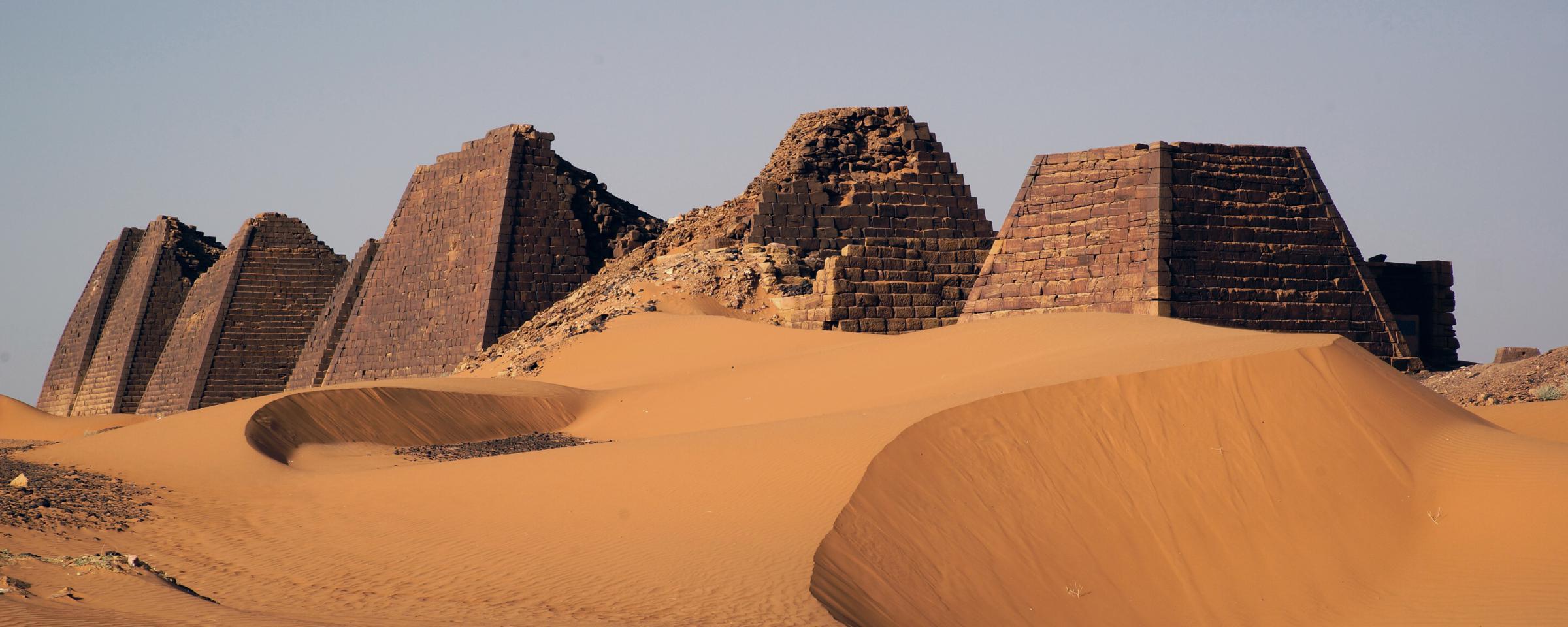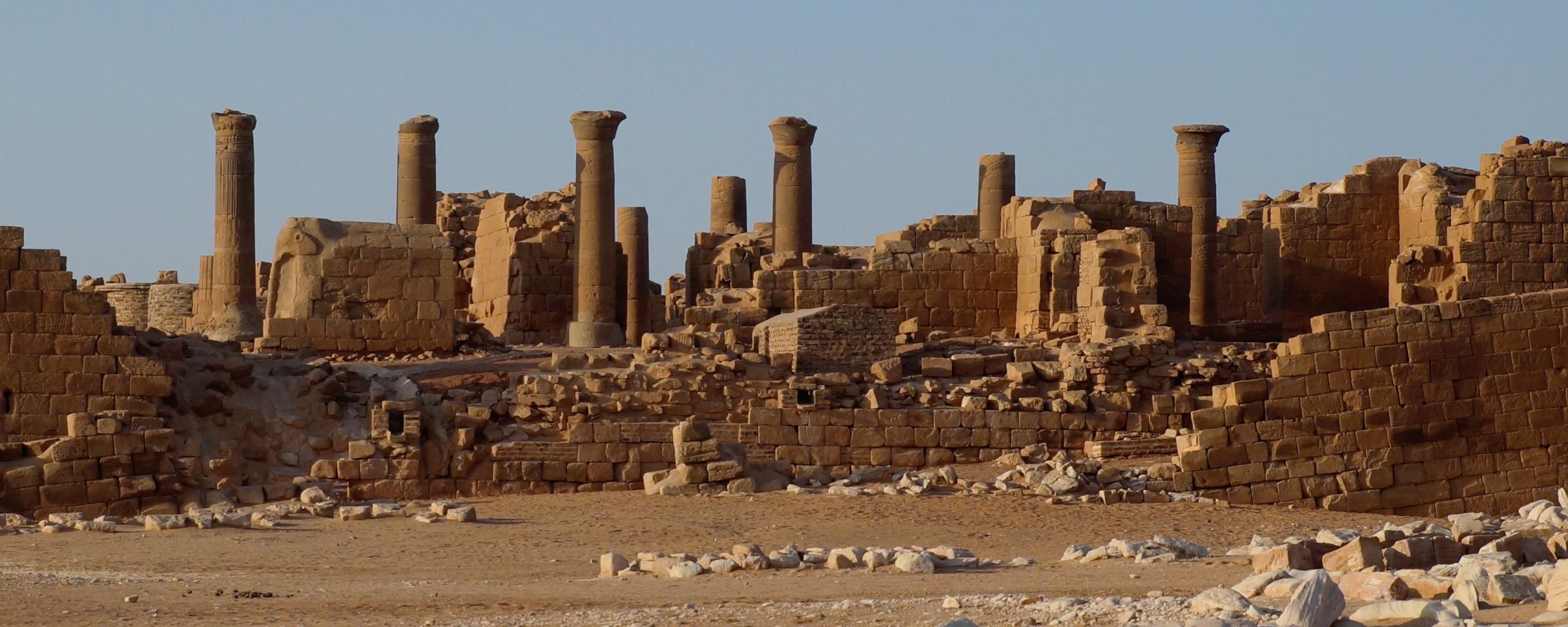Das antike Kusch
Land der schwarzen Pharaonen
Reisen Sie entlang des Nil und durch die Wüste des Nordsudan, wo Pyramidenfelder, Felsgräber und beeindruckende Tempel auf Entdeckung warten. Erkunden Sie die archäologischen Orte in aller Ausführlichkeit und erleben Sie 5000 Jahre Geschichte, z.B. in der bronzezeitlichen Siedlung von Kerma, den ägyptischen Tempeln von Soleb und Sedeinga, den UNESCO-Weltkulturerbestätten am Jebel Barkal und in Meroe, der mittelalterlichen Hauptstadt Old Dongola und den Zeugnissen der Kolonialgeschichte in Khartoum. Genießen Sie die sudanesische Gastfreundschaft, lebendige Märkte und pittoreske Dörfer am Wegesrand. Versenken Sie sich in überwältigende Landschaften und den sternenübersäten Himmel über unserem Wüstencamp. Das ist die perfekte Reise für diejenigen, die den Sudan zum ersten Mal besuchen und seine schönsten Sehenswürdigkeiten kennenlernen möchten.
- Reiseleitung durch einen professionellen Sudanarchäologen
- maximal 11 Reisende
- Fahrt im geländegängigen Fahrzeug mit maximal drei Passagieren
- Entdecken Sie antike Pyramiden, Tempel und Gräber
- Besuchen Sie die beiden UNESCO-Weltkulturerbestätten des Sudan
- Tauchen Sie ein in 5000 Jahre Geschichte
- Erleben Sie den Suk von Omdurman und die Sufi-Zeremonie der tanzenden Derwische
- Genießen Sie die sudanesische Gastfreundschaft
Arrive in Khartoum on an early morning flight (usually between 0100 and 0300). Transfer to the hotel. A room is booked for you so you are able to get a good rest and freshen up.
After a late breakfast, start to explore Sudan's capital city, sample its atmosphere and enjoy several vistas of the Blue and the White Nile. Cross the famous confluence where the two rivers meet to form the iconic main Nile, the world's longest river.
Omdurman, the old capital on the other bank holds important testimonies to the country's recent past. Visit the Mahdi Tomb and Khalifa House, Sudan's national monuments. Enjoy dinner in a typical local restaurant. (B, D)
Begin the journey northward, past the rocky formations of the Sixth Cataract. Visit Wad ban Naga, which boasts a royal palace and several temples of the Meroitic period.
Turn away from the Nile into the semi-desert of the Butana to reach Naga, one of the cities of ancient Kush with several superbly preserved temples still standing. Walk through an avenue of rams to the temple to Amun, built by King Natakamani about two thousand years ago, and explore the richly decorated Lion Temple, dedicated to the lion-headed Kushite god Apedemak. Watch the present-day nomads water their animals at an ancient well right in the centre of the site.
Spend your first night camping in this amazing landscape under a star-strewn sky. (B, L, D)
Continue to Musawwarat es-Sufra, the main sacral centre of the Meroitic lion god Apedemak, about 20 kilometres north of Naga. Musawwarat boasts the enigmatic Great Enclosure, an architecturally unique complex comprising several temples on elevated terraces, connected by ramps and walled passages, surrounded by huge courtyards.
Professor Claudia Näser directed the German mission there, undertaking archaeological research and conservation work at Musawwarat from 2005 to 2015, conducting excavations in the Great Enclosure and restoring the roof of the nearby Apedemak Temple – another marvel of the Meroitic temple architecture, built under king Arnakhamani in the third century BC.
In 2011, Musawwarat was inscribed in the UNESCO World Heritage List as part of the serial property "Island of Meroe", together with Naga and Meroe. To tour the site with a scientist who has been taking part in its exploration is a unique opportunity indeed.
Visit a local nomad camp for tea and spend the night in the magnificent setting of the mountains surrounding the archaeological area.
Another highlight of the trip is the visit to Meroe, the capital of the Kushite Empire in its later days, from the third century BC to the fourth century AD. Meroe was inscribed in the UNESCO World Heritage List as part of the serial property "Island of Meroe", together with Naga and Musawwarat, in 2011.
The site comprises the Royal City, which was excavated in the early 20th century, and boasts several temples, palaces and examples of fancy elite architecture. Further temples and burial grounds can be seen nearby.
The two Royal Necropoleis are located 5 kilometres away from the Nile in a magnificent landscape setting on two hills partly covered by yellow sand dunes. They comprise over fifty pyramids, some of them in perfectly preserved condition, others restored. Already in the 19th century, the British traveller George A. Hoskins stated that "the pyramids of Geezah are magnificent, [...] but for picturesque effect and elegance of architectural design, I infinitely prefer these of Meroe." Judge for yourself!
Overnight at the beautiful Meroe Tented Camp. (B, L, D)
Continue the journey along the Nile and cross to its western bank. From there it's on through the breath-taking landscape of the Bayuda Desert, the area bounded by the Great Bend of the Nile. Stop for photographs and to collect firewood for the night.
Camp will be set up near the remains of the medieval monastery of Ghazali. Abandoned in the 11th century AD, its installations, including two churches, monk cells as well as a dining area and a kitchen tract, are still very well preserved. (B, L, D)
Continue downstream along the Nile and reach Old Dongola, the famous capital of the medieval Nubian kingdom of Makuria. The town's once imposing churches, palaces and houses are buried under huge sand dunes, which even covered the royal quarters of the citadel of the town.
The excavated remains include parts of the gigantic city wall, the cathedral and a range of other churches, some of them with wall paintings, a monastery, palaces and the throne hall of the Makurian kings, which was turned into a mosque after the Islamic conquest of the kingdom in 1317.
Visit the 'abandoned village' and the nearby Muslim cemetery with its impressive domed tomb superstructures, called qubbas.
Beyond Old Dongola, the tarmac road ends. Set up camp in a circle of dunes in the Nubian desert and sense the overwhelming solitude of the desert. (B, L, D)
Reach Kerma with its impressive testimonies of the Bronze Age culture which has taken its name from this site. Behind a museum exhibiting the major finds of recent excavations, the main settlement, or 'city', comprises the remains of numerous mudbrick houses and palaces which are outlined in low reconstructions as well as the so-called Western Deffufa, an enormous mudbrick building which still stands 18 metres tall and which probably once supported the main Kerma temple on its roof.
The nearby cemetery is estimated to comprise more than 30,000 tombs. Some monumental tumuli of more than 90 metres diameter contained the burials of the Kerma kings and queens. Two enigmatic mudbrick buildings which resemble the Western Deffufa are interpreted as the cult chapels of these tombs.
The third site to visit is Dukki Gel where archaeologists are currently uncovering the fortified town which the Egyptians founded when they conquered Kerma around 1500 BC.
Set up camp in the area of the Third Cataract. (B, L, D)
Explore the rocky landscape of the Third Cataract. Discover rock inscriptions which relate to the conquest of Kerma by the Egyptian pharaohs, including the great victory stela of Thutmose I. In the same area, an Egyptian cemetery of New Kingdom date as well as an ancient granite quarry, which still holds the unfinished statue of a Napatan king, are located.
Visit Sudan's largest rock art site at Sabu, with more than 1600 rock drawings from different periods, spanning more than 6000 years from late prehistory to recent times.
Continue north, passing Nubian villages. Spend the night in a private Nubian house, with basic rooms and shared facilities, but clean with western toilets and shower. Those who prefer sleeping under the stars are welcome to put up their tents in the courtyard. (B, L, D)
Undertake a boat trip across the Nile to visit the famous temples of Soleb and Sedeinga which were built in the New Kingdom under Pharaoh Amenhotep III.
The temple at Soleb is a classical Egyptian temple, with a processional route, massive pylons, courtyards and pillared halls. It equals the most important temples in Egypt, both in size and appearance. It was consecrated to Amun-Ra and the king himself.
Its rarely visited companion temple at Sedeinga is the northernmost point of our expedition. This temple was dedicated to queen Tiye as a manifestation of the Eye of Ra. It has undergone substantial excavations in recent years leading to the discovery of many beautifully carved relief blocks which can be visited in an accessible open air storage area.
In-between the two sites is Jebel Dosha, a rocky spur right beside the bank of the Nile, which features a rock-cut chapel of Thutmose III as well as several rock inscriptions of New Kingdom date. Its scenery and setting makes this site particularly attractive.
Overnight as on the previous day. (B, L, D)
Travel south and visit the temple of Amun at Kawa which was built by Taharqo, one of the 'Black Pharaohs' of the 25th Dynasty.
Cross the Nubian Desert to reach the small town of Karima and its famous landmark, Jebel Barkal. This widely visible mountain was believed to be the abode of the god Amun by both Egyptians and Kushites. The New Kingdom pharaohs founded a town, called Napata, and a temple dedicated to Amun at the foot of the mountain. This temple was rebuilt and enlarged several times throughout the Napatan period, to eventually become the largest temple in the Middle Nile valley.
The temple of Mut, the consort of Amun, is partly cut into the mountain. Two nearby pyramid fields date from the Meroitic period, when some kings and queens decided to build their tombs in this sacred landscape.
Jebel Barkal and the sites of the Napatan region were inscribed into the UNESCO World Heritage List in 2003.
Spend the night in the Nubian Resthouse, a charming boutique hotel on spacious well-kept grounds. (B, L, D)
Explore the pleasant market in Karima and the monuments at Jebel Barkal at your leisure.
Later in the day, visit Kurru, the ancestral cemetery of the Kushite rulers who came to rule over Egypt as the 25th Dynasty. The earliest tombs in this necropolis were built as tumuli, i.e. mound graves, while later generations started to erect Egyptian-style pyramids. Some of the underground burial chambers preserve rich painted decoration.
Take a detour to the petrified forest and the late antique tumulus field of Zuma.
Overnight as on the previous day. (B, L, D)
During the last day in the field, cross the Nile to visit Nuri, the third royal necropolis in the Napatan region. It was founded by Taharqo, who ruled over Egypt and Kush as the third king of the 25th Dynasty in the early seventh century BC. His pyramid is the largest in Sudan, the sides measuring 52 metres in length at the base.
Stop at the temple of Amun at Sanam and the late antique tumulus field of Tanqasi.
Return to Khartoum on the tarmac road through the Bayuda Desert, taking tea at Tamtam, Sudan's most famous roadhouse. Enjoy the hospitality of your Khartoum hotel. (B, L, D)
Spend a fabulous last day in Khartoum, savouring the rhythm of Sudanese metropolitan life. Visit the National Museum which houses finds from all the visited sites – making it at a perfect place to recall the adventures and experiences of the trip.
After lunch at a local restaurant along the banks of the Nile, explore the famous souk in Omdurman, said to be one of the largest markets in Africa. Proceed to Hamad al-Nil' tomb where the Sufi ceremony of the Whirling Dervishes starts one hour before sunset (on Fridays only).
Enjoy a good-bye dinner at the hotel or in one of Khartoum's specialty restaurants. (B, L, D)
Transfer to the airport for an early morning flight (usually between 0200 and 0400), arriving at your home destination later the same day.
Hinweis:
Wenn Sie Interesse an dieser Reise haben, kontaktieren Sie uns bitte unter info@discoversudan.de









